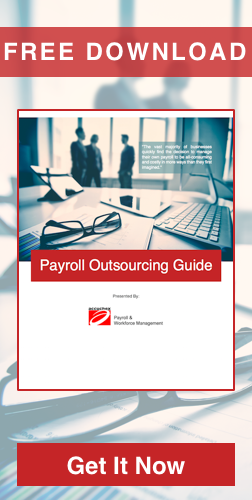 California labor laws can be complex. Navigating through the regulatory maze as part of your regular payroll management functions can be confusing and frustrating for both the employer and employee.
California labor laws can be complex. Navigating through the regulatory maze as part of your regular payroll management functions can be confusing and frustrating for both the employer and employee.
Topics such as split shifts, employee classification, and post-shift activities require time and research to ensure proper compliance.
One of the best approaches is to develop and implement a process for regularly reviewing and updating your compliance procedures in regards to CA labor laws. Designating one staff member as the "point person" for researching an updating compliance matters can help to ensure that your payroll management practices are always up to date and in accordance with annual changes.
Keeping Up With California Labor Laws
Every business is different. Some California employers have employees across a number of other states, or in other countries. Many only employ part-time employees, while others regularly have overtime hours worked and multiple shifts.
Each year, it seems, brings new legislation with additional or changed regulations and reporting requirements. The State of California Department of Industrial Relations (DIR) and other agencies work to keep employers apprised of these updates and changes. However, without due diligence on the part of the business, it is easy to overlook certain requirements. And these oversights can potentially lead to costly claims and penalties.
Key Labor Law Issues
While there are a number issues that occasionally crop up regarding labor laws for California employers, here are some of the more frequent, or common, ones.
According to the labor law, hours worked means “the time during which an employee is subject to the control of an employer, and includes all the time the employee is suffered or permitted to work, whether or not required to do so.”
The state of California permits “rounding” of employee time to the nearest one-tenth, five minutes, or a quarter hour for calculating actual hours worked. This approach is not allowed, however, if it can result in the failure to properly compensate your employees for the time they have worked.
Employers are allowed to disregard “insignificant periods of time” outside the regular scheduled working hours that cannot be precisely recorded for payroll purposes. This only applies, however, if these periods of time are occasional periods of time that only last a few seconds or minutes.
2. Meal Breaks

In California, employees must be provided with a meal break of at least 30 minutes if they work more than five hours in the day. This meal period must begin before, or at, the end of an employee’s fifth hour of work. If an employee works more than 10 hours in the same day, a second meal period is due.Employers are not required to pay for meal periods and employees should clock in and out for meal periods.
In a 2012 court case, the California Supreme Court held that there is no prohibition on taking meal periods early in a shift, although this can result in an employee working more than five hours after the meal. In addition, the court also made it clear that employers must provide meal breaks, but that they do not need to require that employees use those breaks.
During meal breaks, employers must relieve employees of all duties, cannot regulate their activities, and must permit them a “reasonable opportunity” to take an uninterrupted 30-minute break. And, while employers cannot not “impede or discourage” employees from taking a meal break, they are not required to ensure that no work is being done during those breaks.
Meal periods may be waived in certain limited situations:
- If the employee will work no more than six hours total in the day, and the employee and employer agree to waive the meal period; and
- If the employee works between 10 and 12 hours, the second meal period may be waived if the first meal period was not waived.
3. Rest Breaks
California labor law requires that employers must “authorize and permit” employees to take one 10-minute rest period for each four-hour work period, or “major fraction thereof.” According to the California Supreme Court, anything more than two hours is a “major fraction” of four hours. Therefore, rest periods must be provided at as follows:
- Employees working between 3 1/2 and 6 hours are entitled to one paid 10-minute break
- Employees working between 6 hours and 10 hours are entitled to two paid10-minute breaks
- Employees working between 10 hours and 14 hours are entitled to three paid 10-minutes breaks; and so on.
However, a rest break is not required for employees whose total daily work time is less than three and one-half hours. Although no specific timing is required, the rest breaks should be taken, to the extent that it is reasonable, in the middle of each work period.
In general, if an employee is working an eight-hour shift, one rest break should be before the meal break, and one should be after. Remember, rest breaks count as time worked, and so employees must be paid for this time. Employers are also required to provide suitable resting facilities such as a break area or kitchen.
If the employer does not allow an employee to take a rest period, the employee is entitled to one hour of pay at the employee’s regular rate of pay for each workday that rest periods are not made available. This includes not only rest periods required under California’s wage and hour laws, but also recovery periods, or cool down periods, allowed for employees to prevent heat illness under various state laws and regulations.
4. Training, Lectures and Meetings
In determining whether employees need to be paid for time spent attending training, lectures, and meetings, California follows the federal law. As such, time is not counted as “hours worked” if:
- Attendance is outside regular work hours
- Attendance is voluntary
- The course, lecture or meeting is not related directly to the employee’s job training, and
- The employee does not perform any productive work during the training, lecture or meeting
5. Travel Time
Note that California law and federal law differ regarding rules on travel time. California mandates that employees be paid for all hours they are engaged in work-related travel, regardless of whether those hours are during “normal” working hours, or for longer assignments. The employer can, however, establish a different rate of pay for travel time.
The California law does not require employers to pay employees for commuting to and from work, however. Note also that employers who require their employees to use personal vehicles for work may be liable for employee car accidents during a commute or even on a personal errand during "normal" work hours
6. Reporting Time Pay
Occasionally, employees may report to work, but for certain reasons are not put to work, or are provided with less than half of the usual or scheduled days’ wages. In those situations, employees are entitled to reporting time pay. This means that employees are required to be paid for half of the usual or scheduled day’s work, but not less than two hours, nor more than four hours, of their normal wages.
Also, employees who are required to report for work a second time on any one workday and are furnished less than two hours of work on the second reporting must be paid for two hours at their regular rate of pay.
Requirements for providing reporting time pay do not apply if:
- Operations cannot continue or commence due to threats to employees or property
- Civil authorities recommend that operations not continue or commence
- There is a failure to public utilities or sewer system
- The interruption is caused by an act of God or other cause not in the control of the employer
Payroll Management Best Practices and Labor Laws
While outsourcing payroll is not the answer for every smaller business, the advantages and benefits are worth investigating. In addition to reducing your in-house costs, increasing accuracy and security, you can benefit by shifting your limited HR resources to improving operational functions, recruiting efforts, and training.
As a business owner or payroll manager you have a number of options for your payroll functions. Software that can be installed in-house, or cloud-based programs offer a good alternative. But if you really want to take full advantage of the benefits available to you, outsourcing to a provider like Accuchex can still be the best decision.
Reliability, full-service options, and reputation are the hallmarks of a quality payroll management service provider. If you are currently looking to invest in outsourcing you get your Free Download: Payroll Outsourcing Guide to help you make an informed decision or call Accuchex Payroll Management Services at 877-422-2824.



